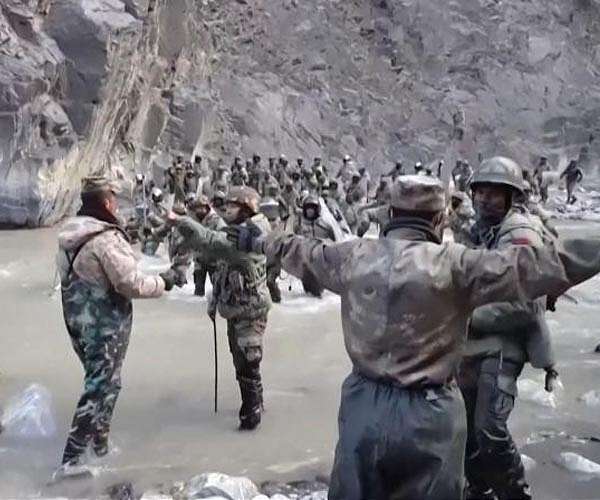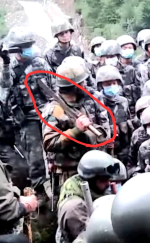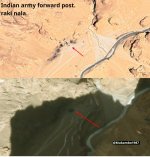Despite the deal with the Chinese to go back to pre-2020 status quo, we shouldn't drop our guard down and continue with our military modernisation. As long as the Chinese occupy Tibet, there never will be peace between India-China.
Line of Actual Control (LAC) : India & Tibet Border Updates
- Thread starter Shashank
- Start date
You are using an out of date browser. It may not display this or other websites correctly.
You should upgrade or use an alternative browser.
You should upgrade or use an alternative browser.

China says reached 'resolution' with India on contested border issues
Beijing (AFP) Oct 22, 2024 - China said Tuesday it had reached a resolution with India over issues related to their disputed border, after New Delhi said it had struck a deal with Beijing for military patrols along the frontier.
www.spacewar.com
This is more of a tactical pause , as both cntries know that any conflict will only benefit the 3rd party. This is going to enrage US even more , get ready for more pricks & pinches.Despite the deal with the Chinese to go back to pre-2020 status quo, we shouldn't drop our guard down and continue with our military modernisation. As long as the Chinese occupy Tibet, there never will be peace between India-China.
Joint verification of disengagement on, patrolling to start at Depsang soon.Temporary Structures at Depsang, Demchock removed. Physical verification process on.


Sigh of relief for us! Now we should continue to build our military like we've done since 2020, to thwart PLA when that eventual time comes in the future.
Those photos of our guys being mocked were released because we had detained about 100+ pla in Arunachal Pradesh. Not new at all. Real question is our version of events true for galwan? Were there more pla dead than reported?Some new of photos & videos of PLA receiving some whooping from IA. Date & place of this incident is yet to be ascertained:
It that a naga dao?
View attachment 37982
5 years since Galwan, how India has fortified border with reforms and roads
Five years since the Galwan clash in 2020 in which 20 Indian soldiers were killed, India has fortified its border defences, overhauled military preparedness, and stepped up diplomacy with China along the Line of Actual Control (LAC).The Galwan clash, which saw Indian troops retaliate without firearms under existing protocols, also caused significant casualties on the Chinese side and marked a complete breakdown in trust between the two neighbours.
In the years since, India has significantly restructured its military preparedness, reinforced border infrastructure, and intensified diplomatic engagements. The Indian armed forces enhanced their presence across the LAC, especially in Eastern Ladakh, with rapid deployment of troops and high-altitude warfare equipment. Emergency procurement provisions were invoked to expedite defence acquisitions, including surveillance systems, UAVs, artillery, and medical equipment for extreme terrain.
The Galwan incident became a catalyst for infrastructure expansion. The Union Budget for FY 2025-26 allocated Rs 6.81 lakh crore to the Ministry of Defence, a 9.53% increase from the previous year. Of this, Rs 7,146 crore was set aside for the Border Roads Organisation (BRO), which completed 75 projects worth Rs 2,236 crore in 2024 alone.
These include roads and bridges in strategic regions like Ladakh, Arunachal Pradesh, Sikkim, and Himachal Pradesh. BRO's earlier achievements included the world’s highest motorable road at Umling La (19,024 feet) and ongoing development of the Nyoma Airfield and Shinku La tunnel.
The last five years have also seen the LAC’s digital landscape transformed. Remote villages in Ladakh, including Galwan and Demchok, were connected to 4G networks under a joint initiative by the Indian Army and Bharti Airtel. This step opened up access to telemedicine, digital education, and government schemes, with the potential to improve tourism and local livelihoods.
On the diplomatic front, over 30 rounds of talks have taken place since 2020. India and China have conducted 21 rounds of Corps Commander-level discussions and multiple Working Mechanism for Consultation & Coordination (WMCC) meetings. Disengagement has occurred at several friction points: Galwan in July 2020, Pangong Tso in February 2021, PP17A (Gogra-Hot Springs) in August 2021, PP15 in September 2022, and most recently, at Demchok and Depsang in October 2024.
High-level diplomatic meetings also continued. On June 12, 2025, Foreign Secretary Vikram Misri met Chinese Vice Foreign Minister Sun Weidong in Delhi to discuss bilateral ties, people-centric engagement, and reopening direct air services. Talks included progress on resuming hydrological data sharing and finalising an updated air services agreement. Visa facilitation, media exchanges, and commemorations of 75 years of India-China diplomatic relations were also discussed.
Despite partial disengagement, India remains cautious. “Galwan was a turning point,” says Maj Gen Ashok Kumar (Retd), Director General of Centre for Joint Warfare Studies. “It shattered all trust in Chinese political and military leadership. India’s vigilance along the LAC is now permanent.”
India’s response post-Galwan is widely seen as a comprehensive shift—not only in defence and diplomacy but in redefining the strategic calculus of border management. The clash, now etched in national memory, has ensured that preparedness, infrastructure, and international positioning are not reactive but proactive.





